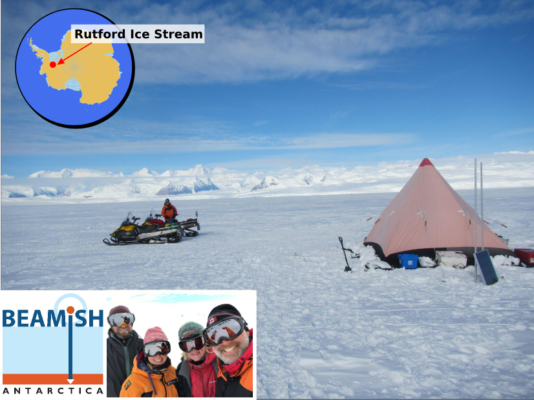
Each day, several tens of tiny earthquakes happen beneath Rutford Ice Stream in Antarctica. These events are so small that no human would be able to feel them – yet, scientists can use recordings of these so-called “icequakes” to obtain valuable information on the way ice flows in Antarctica. Read on to find out how…
What are icequakes?
So we’ve all heard of earthquakes, but what about icequakes? Icequakes are seismic events that happen through the sudden cracking of ice or frozen rock. Like tectonic earthquakes, these events release energy and create seismic waves which travel through the ice and can be recorded at the ice surface using geophones (a sort of microphone that records ground movements). Like an X-ray through a human body, the ground-motions that geophones record carry information about the internal structure of the ice along the travel path of the seismic waves all the way back to the source of the icequake.
Why do we look at icequakes?
In Antarctica, ice streams (regions of fast-flowing ice within an ice sheet) make up only ~10% of the entire ice sheet’s volume but they contribute ~90% of the total ice volume leaving the continent (read the Rignot et al. (2019) paper for more info) . Ice streams transport large volumes of ice and sediments towards the sea and therefore have a large impact on global sea level. Understanding how ice streams flow and behave is fundamental to predict Antarctica’s future contributions to sea level rise. This is where icequakes come into the picture. By providing information on the structure of the ice that they travel through, icequakes can help us understand how deformation occurs within the ice, as well as at the ice-bed interface, i.e. where the ice and underlying sediments or rock are in contact. It is this deformation of the ice or the bed beneath the ice that controls the flow of ice streams.
Hunting for icequakes
An international team of scientists and collaborators have been collecting geophysical, geological and geochemical datasets on Rutford Ice Stream (Figure 1) as part of the BEAMISH project (Basal Conditions on Rutford Ice Stream; read this previous blog post for further information). Rutford is a major, fast flowing Antarctic ice stream that transports ice from the West Antarctic Ice Sheet towards the Ronne Ice Shelf at a speed of about one meter per day.
During the field season of 2018/19, a team of three scientists successfully drilled through the ~2 km thick ice at Rutford Ice Stream to recover some rock samples from the bed and obtain direct measurements of the temperature and fluid pressure at the ice stream bed. From these samples and geophysical data, we learnt that the bed beneath Rutford Ice Stream is made up of two different types of sediments: an area of stiff, compacted sediments, and another area composed of softer and unconsolidated sediments (read the Smith, (1997) paper for more info). Basal icequakes are triggered through the motion of the ice stream on top of its bed (read the Smith et al. (2015) paper for more info). These basal icequakes happen frequently beneath Rutford Ice Stream and release seismic energy exclusively from regions near the bed. Based on this knowledge, the BEAMISH study area represented the ideal location to further investigate the bed characteristics, and therefore the bed’s impact on the ice stream’s flow, using passive seismic measurements. (i.e. through the listening of seismic events that occur naturally, not man-made such as described in this previous blog post about active seismics).
What did we do in Antarctica this field season?
During the most recent field season in 2019/2020, a team of three scientists from the British Antarctic Survey (BAS, including myself) and the University of Oxford and our field guide, were flown to Rutford Ice Stream to study the bed properties at the base of the ice stream. We deployed our seismic instruments aiming to obtain a high-resolution snapshot of the bed beneath the ice. We arranged geophones in a seismic array, which involves setting the geophones on the ice surface in a very dense grid which makes the array highly sensitive to very weak seismic waves. You can think of the seismic array set-up as comparable to an optic lens which zooms into a specific region of interest. We also tested a new technique for detecting icequakes called Distributed Acoustic Sensing (DAS, Figure 2) for the first time in Antarctica. The DAS technique uses a fiber optic cable stretched across the ice surface which can detect small strain changes (i.e. cable length changes) introduced by seismic waves. The advantage of DAS is that it is very sensitive to small changes such as the ones that might be introduced by icequakes.

Figure 2: Mike Kendall walking along the DAS cable to check its connection to the ground. The black flags in the far distance are the geophone seismic array. Figure courtesy of Alex Brisbourne.
What did we find out?
Our initial data analysis shows that we recorded several thousands of icequakes during our six week measurement period! The events detected are extremely weak. In fact, they would feature as negative magnitudes on the Richter scale! This suggests that the icequakes we measured were triggered by motions of the ice stream above the bed of only a few centimeters. Interestingly, we found that these icequakes arrange into a characteristic pattern related to the changing bed composition beneath the Rutford Ice Stream. Stay tuned for more fascinating results soon to follow!
Further reading:
• British Antarctic Survey page
• Link to Mike Kendall’s page at University of Oxford
• BEAMISH project
• Previous Cryoblog post on BEAMISH
• Rignot, E., Mouginot, J., Scheuchl, B., van den Broeke, M., van Wessem, M. J., & Morlighem, M. (2019), Four decades of Antarctic Ice Sheet mass balance from 1979–2017, Proceedings of the National Academy of Sciences, 116(4), 1095-1103, doi:10.1073/pnas.1812883116
• Smith, A. M. (1997), Basal conditions on Rutford ice stream, West Antarctica, from seismic observations, Journal of Geophysical Research: Solid Earth,102(B1), 543-552, doi:10.1029/96JB02933
• Smith, E. C., Smith, A. M., White, R. S., Brisbourne, A. M.,& Pritchard, H. D. (2015), Mapping the ice‐bed interface characteristics of Rutford Ice Stream, West Antarctica, using microseismicity, Journal of Geophysical Research: Earth Surface,120(9), 1881-1894, doi:10.1002/2015JF003587
Edited by Jennifer Arthur and Marie Cavitte
 Sofia-Katerina Kufner trained as a geophysicist and seismologist. She collects and analyses seismological data to understand active processes on various scales ranging from tectonic deformation to glacial microseismicity. She is currently working in the Ice Dynamics and Palaeoclimate Team at the British Antarctic Survey on the BEAMISH project. Within this project she uses glacial induced microseismicity to understand the frictional properties of the ice-bed interface, which is one of the key factors controlling glacial flow dynamics. Contact email: sofner@bas.ac.uk.
Sofia-Katerina Kufner trained as a geophysicist and seismologist. She collects and analyses seismological data to understand active processes on various scales ranging from tectonic deformation to glacial microseismicity. She is currently working in the Ice Dynamics and Palaeoclimate Team at the British Antarctic Survey on the BEAMISH project. Within this project she uses glacial induced microseismicity to understand the frictional properties of the ice-bed interface, which is one of the key factors controlling glacial flow dynamics. Contact email: sofner@bas.ac.uk.
